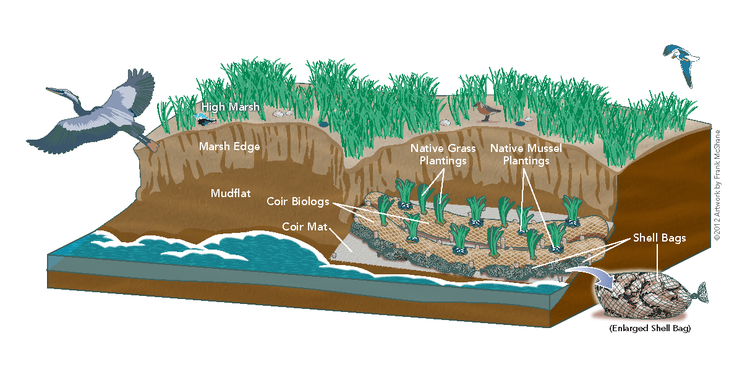Coastal Wetland Protection
Coastal wetland protection is a critical climate solution that leverages natural ecosystems to mitigate climate change impacts, reduce flooding, and sequester carbon. This page explores the progress, challenges, and future directions of coastal wetland protection efforts.

Image credit: Delaware Living Shorelines Committee
View open jobs in this Solution
Example Organizations
- The Nature Conservancy - Global conservation organization working on coastal wetland protection and restoration.
- Wetlands International - Non-profit dedicated to the conservation and restoration of wetlands.
- Environmental Defense Fund - Focuses on using science and economics to solve environmental problems, including coastal protection.
- Restore America's Estuaries - Alliance of coastal conservation organizations dedicated to protecting and restoring coastal habitats.
- Conservation International - Environmental organization working on nature-based solutions, including coastal ecosystem protection.
Overview
Coastal wetland protection involves preserving and restoring wetland ecosystems to harness their natural ability to store carbon, reduce wave energy, and mitigate flooding. These ecosystems serve as critical buffers against climate change impacts while providing numerous ecological benefits.
- Wetlands: Key for carbon storage and water management - Climate Tech Distillery
- NOAA - Coastal Wetlands
- EPA - Coastal Wetlands
Progress Made
Significant advancements have been made in coastal wetland protection:
- Wetland Restoration: Development of techniques to restore degraded wetlands.
- Green Infrastructure: Implementation of nature-based solutions in coastal areas.
- Living Shorelines: Creation of stabilized coastal edges using plants, sand, and rock.
Solutions by Sector
Conservation
- Protected Areas: Establishing and managing coastal protected areas.
- Ecosystem-Based Management: Implementing holistic approaches to coastal management.
- Blue Carbon Projects: Developing projects that leverage coastal ecosystems for carbon sequestration.
Case Studies:
- Louisiana's Coastal Master Plan: Comprehensive approach to restore and protect Louisiana's coast (Coastal Protection and Restoration Authority).
- Mikoko Pamoja Project, Kenya: Community-led mangrove conservation and restoration project (Mikoko Pamoja).
- The Great Marsh Restoration, Massachusetts: Large-scale salt marsh restoration project (The Nature Conservancy).
Engineering
- Hybrid Infrastructure: Combining natural and engineered solutions for coastal protection.
- Sediment Management: Techniques to enhance natural sediment accretion in wetlands.
- Hydrological Restoration: Restoring natural water flows in degraded wetlands.
Case Studies:
- Living Breakwaters, New York: Innovative coastal resilience project combining engineered breakwaters with habitat enhancement (SCAPE).
- Wallasea Island Wild Coast Project, UK: Europe's largest coastal wetland restoration project (Royal Society for the Protection of Birds).
- Beneficial Use of Dredged Material, Netherlands: Using dredged sediment to enhance salt marshes (EcoShape).
Policy and Planning
- Coastal Zone Management: Developing integrated policies for coastal areas.
- Flood Risk Mapping: Creating detailed maps to inform coastal planning.
- Climate Adaptation Strategies: Incorporating wetland protection into climate adaptation plans.
Case Studies:
- California Coastal Act: Comprehensive legislation for coastal protection and management (California Coastal Commission).
- Bangladesh Delta Plan 2100: Long-term, holistic plan for the Ganges-Brahmaputra-Meghna Delta (Government of Bangladesh).
- New Zealand Coastal Policy Statement: National policy framework for managing coastal environments (Department of Conservation).
Lessons Learned
- Ecosystem Approach: Successful projects consider the entire ecosystem, not just individual species or habitats.
- Community Engagement: Involving local communities is crucial for long-term project success.
- Adaptive Management: Flexibility in management strategies is necessary to respond to changing conditions.
- Economic Valuation: Demonstrating the economic value of wetlands helps garner support for protection efforts.
Challenges Ahead
- Sea Level Rise: Accelerating sea level rise threatens many coastal wetlands.
- Funding: Securing long-term funding for protection and restoration projects remains difficult.
- Land Use Pressures: Competing demands for coastal land use often conflict with conservation goals.
- Climate Change Impacts: Changing temperature and precipitation patterns affect wetland ecosystems.
Best Path Forward
- Integrated Coastal Management: Adopt holistic approaches that consider multiple stakeholders and ecosystem services.
- Increased Investment: Secure more funding for wetland protection and restoration projects.
- Improved Monitoring: Develop better tools and methods for assessing wetland health and project outcomes.
- Policy Support: Implement policies that prioritize wetland protection and discourage harmful coastal development.
- Public Education: Increase awareness about the importance of coastal wetlands and their role in climate change mitigation.
Image credit: Delaware Living Shorelines Committee